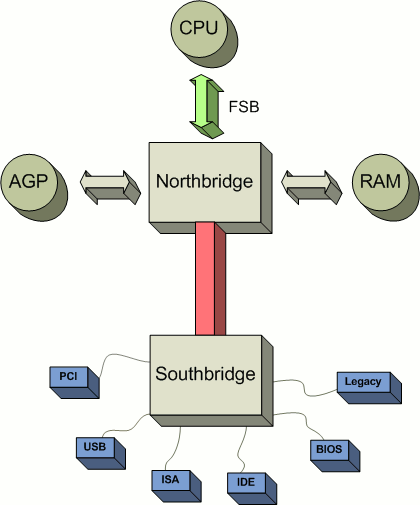Learning Resources
Chipset
A chipset, PC chipset, or chip set refers to a group of integrated circuits, or chips, that are designed to work together. They are usually marketed as a single product.
In home computers, game consoles and arcade game hardware of the 1980s and 1990s, the term chipset was used for the custom audio and graphics chips. Examples include the Commodore Amiga's Original Chip Set or SEGA's System 16 chipset.
Based on Intel Pentium-class microprocessors, the term chipset often refers to a specific pair of chips on the motherboard: the northbridge and the southbridge. The northbridge links the CPU to very high-speed devices, especially main memory and graphics controllers, and the southbridge connects to lower-speed peripheral buses (such as PCI or ISA). In many modern chipsets, the southbridge contains some on-chip integrated peripherals, such as Ethernet, USB, and audio devices.
The manufacturer of a chipset often is independent from the manufacturer of the motherboard. Current manufacturers of chipsets for x86 motherboards include AMD, Broadcom, Intel, NVIDIA, SiS and VIA Technologies. Apple computers and Unix workstations have traditionally used custom-designed chipsets. Some server manufacturers also develop custom chipsets for their products.
Traditionally, in both AMD and Intel variations, the processor is coupled with two other integrated circuits: the northbridge, which is responsible for communications with high-speed devices, such as memory and graphics cards; and the southbridge, which implements comparatively low speed peripherals, such as USB, parallel and serial communications. The lanes connecting the processor and system memory are known as the front side bus (FSB). The interface between the CPU and graphics device(s), whether AGP, PCI or integrated into the motherboard, is directly controlled by the northbridge IC. In 2003, AMD introduced the Athlon 64-bit processor which, in addition to introducing 64-bit CPUs to the PC market, integrated the memory controller into the CPU, allowing direct communication between the processor and memory, a protocol termed "HyperTransport". Intel followed suit in 2008 with the release of its Core i series CPUs; Intel dubbed the new, faster interconnect between CPU and system memory as "QuickPath". On new Intel-based motherboards, the whole purpose of the northbridge is to provide an interface between the CPU and graphics card(s). In some newer Intel configurations, the northbridge and southbridge have been consolidated into a single IC, the "Platform Controller Hub" (PCH), effectively an enhanced southbridge. Some Intel and AMD CPUs have also included a GPU onboard (so-called APUs), though external graphics adapters are still allowed or even crossfireable (with AMD APUs). In this case, the PCH retains southbridge functions for lower rate peripherals.
An schematic of northbridge -


